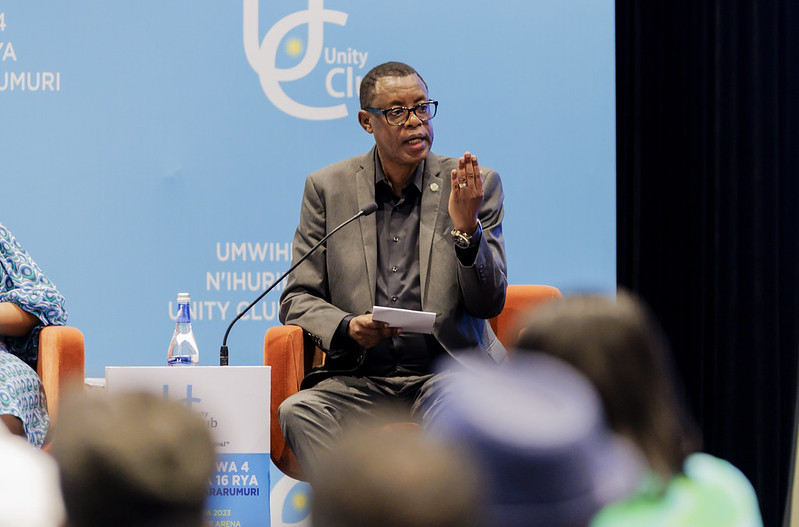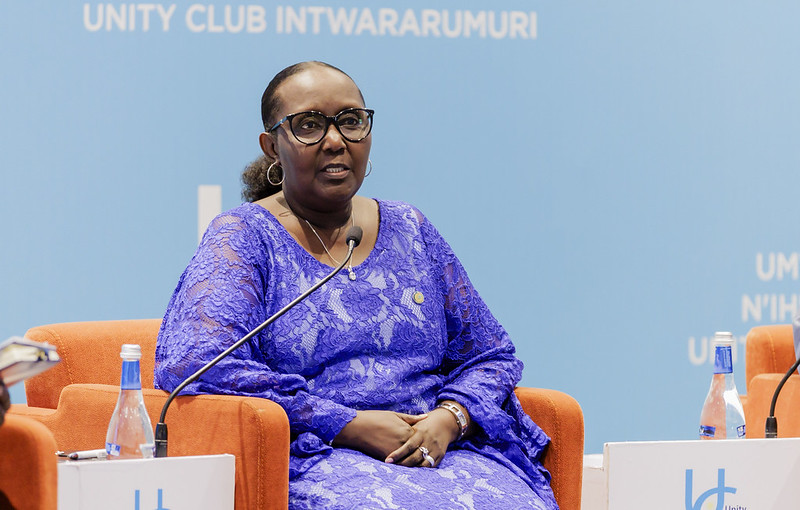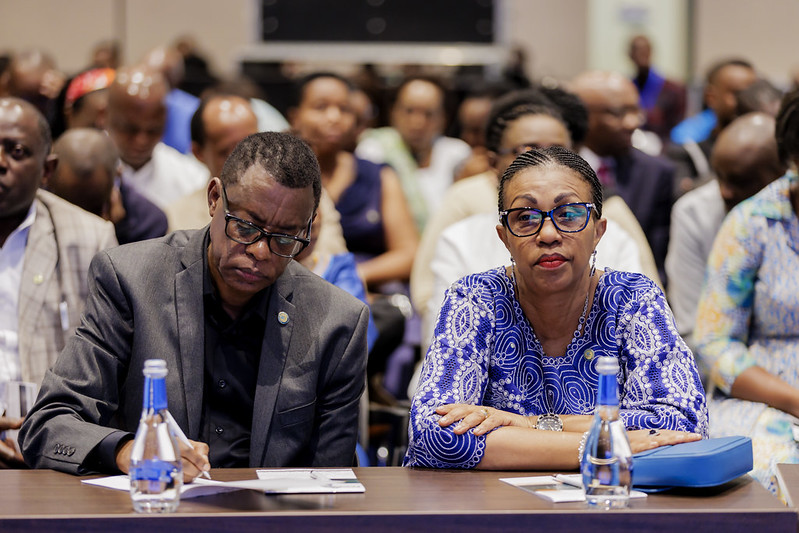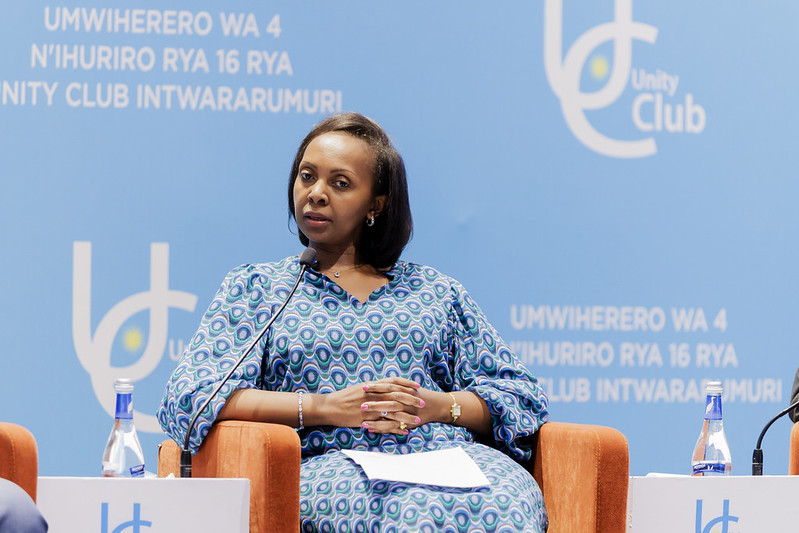
Gen.(Rtd) James Kabarebe
Gen. (Rtd) James Kabarebe today shared a story of Rwanda’s liberation and its heavy cost, including hostilities from their enemy who would not shy away from killing war prisoners including women.
Kabarebe who is current Minister of State in the Ministry of Foreign Affairs was on the panel of senior members of Unity Club Intwararumuri which held the 16th General Assembly.
He brought a brief story of liberation when the moderator asked him what was more of an uphill task between teaching Ndi Umunyarwanda and inculcating military skills/spirit among the combatants of the Rwanda Patriotic Army (RPA) Inkotanyi during the liberation struggle.
“Before liberating the country, we first liberated ourselves. We defined the enemy who was the Rwanda’s system of divisionism. We did not have anything against citizens of Rwanda, we were fighting the army which was protecting a system of hatred.”
Kabarebe said that on his turn, the enemy of RPA Inkotanyi defined their enemy in one simple word “The enemy of Rwanda’s regime under President Juvénal Habyarimana was simply the Tutsi,” Kabarebe said.
RPA thus engaged Habyarimana’s regime and experienced several hardships, but one thing shocked Kabarebe the most.
“In 1993 during Arusha peace agreement, we noted that there was a number of war prisoners on either side and we agreed to exchange them. We handed 59 soldiers to Habyarimana’s regime, and in their turn, they just gave us three old men. Can you imagine that our enemy used to kill those he took hostage,” Kabarebe said.
“Habyarimana would not even spare the women. In Rwandan culture, that had never happened before-a belligerent killing women.”

Domitile Mukantaganzwa was also on the panel
Of all those women for example, Kabarebe would recall Caporal Rukotana, a female fighter whom the Rwanda army tortured severely.
However, as far as RPA is concerned, there are government soldiers who chose to remain with them, to fight on the side of RPA.
Kabarebe who has names of key people in the struggle on his fingertips said that those soldiers were very useful to RPA because they knew quite well the whereabouts of Habyarimana soldiers.
“If we did not have combatants like Minani for example, we wouldn’t make it during the Ruhengeli II battle,” he said.
“He showed us the trace of our enemy and we succeeded to besiege Ruhengeri.”
RPA’s Humanism above everything
Kabarebe shared several practical examples that show how the RPA chose humanism at any cost through its fight, a spirit that would be the basis of the Rwanda Defence Force(RDF).
Slightly after stopping the Genocide, Kabarebe recalls that 1500 new soldiers were reintegrated in the army, including those from the government that had been overturned.
“Some were not sure about their future in the army. They thought that RPF was trying to find away to eliminate them, others thought they would just do evil after they get guns, but they all found strong basis from the RPA spirit and they followed suit,” Kabarebe recalls.
In 1996, Kabarebe recalls that they had a homogeneous army which went to the mission of repatriation of the Rwandan refugees in Democratic Republic of Congo (DRC). Something strange happened.
“We arrived to the field, trough the refugee camps, but the Ex-force armée Rwandaise(Ex-FAR) which had mixed with civilians fought us. In the middle of the fight in Nyamuragira volcano, the later erupted and either side fled the lava,” Kabarebe recalls the story.
 At that time, some Rwandan refugees in DRC wanted to proceed further to Mugunga passing in the middle of Nyiragongo and Nyamuragira, which was a danger at that time because the lava could surprise them.
At that time, some Rwandan refugees in DRC wanted to proceed further to Mugunga passing in the middle of Nyiragongo and Nyamuragira, which was a danger at that time because the lava could surprise them.
“We deployed soldiers to stand at a strategic place to deviate the refugees so that they do not fall into the inferno,” Kabarebe said amid of applause to RDF’s professionalism just two years after liberating the country as RPA.
Integration of the Elderly cadres Like Kanyarengwe, Lizinde
While recruitment and reintegration of the young ones was more or less seamless, it required a little bit more patience to have elderly members of the RPA to understand the ideology and to marry the Ndi Umunyarwanda spirit.
Kabarebe recalls Col. Alexis Kanyarengwe who was chairman of RPA and his change, given the age and his history, was a long process.
Same applies to others like Col Lizinde, Biseruka and Muvunanyambo who were released from Ruhengeri prison.
“One funny example is when on command post in Byumba, Lizinde heard news that Kanombe military camp had fallen in RPA hands and he said: The bastards-inyana z’imbwa- have taken Kanombe! Okay! Wait when the commandos of Bigogwe come. They will show them what they are made of,” Kabarebe recalls.
“He used to say such words and we could laugh at some of them but we could understand that with his history there was some understanding he could not afford.”
On this panel was also Donatille Mukantaganzwa, President of law reform commission. She said that the RPA spirit was a game changer; it gave Rwanda a leadership which is mindful of citizen’s life.
 Also featuring on this panel was the daughter of late Dr. Akingeneye, who was the medical personnel of President Juvenal Habyarimana and who died with the later during the crash of the plane who carried the former head of state.
Also featuring on this panel was the daughter of late Dr. Akingeneye, who was the medical personnel of President Juvenal Habyarimana and who died with the later during the crash of the plane who carried the former head of state.
“As if this was not enough, during the Genocide the family of my mother was exterminated. It was hard to bear for me,” she said adding that she was personally mistreated at work after she was given an opportunity to serve the country, but she carried on.
Panelists understand that the genocide ideology which is still vehiculated by negative groups like the DRC based FDLR and those who hide behind the so called “rights” could bring back the country to ush if the country takes the matter lightly.

